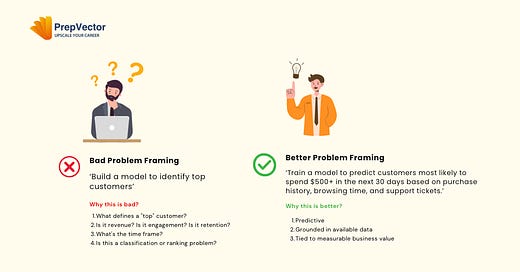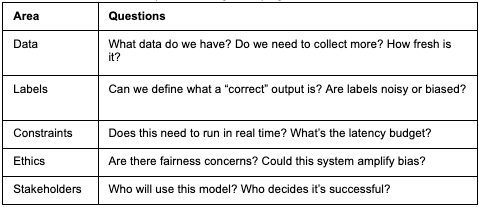Part 2: From Business Question to ML Problem — Scoping It Right
Turning vague goals into actionable ML problems starts with the right framing. In this post, we break down how to scope business questions into precise, data-driven solutions.
👋 Hey! This is Manisha Arora from PrepVector. Welcome to the Tech Growth Series, a newsletter that aims to bridge the gap between academic knowledge and practical aspects of data science. My goal is to simplify complicated data concepts, share my perspectives on the latest trends, and share my learnings from building and leading data teams.
"Give me a machine learning model that increases revenue."
If this is how your ML project starts, it’s already in trouble.
Before you write a single line of code, collect a dataset, or spin up a GPU — you must first frame the right problem. Most failed ML projects aren’t caused by modeling issues. They fail because they solve the wrong problem — or a poorly defined one.
This post walks you through:
How to frame business problems as ML problems
How to define success before building anything
What questions to ask during scoping
A real example of good vs bad problem framing
✅ Why Problem Scoping Matters in ML
Machine learning isn’t magic. It optimizes for what you ask it to optimize — no more, no less.
Poor scoping leads to:
Models that are technically accurate but useless in production
Wrong success metrics (e.g., accuracy when cost savings matter)
Incomplete problem framing that ignores edge cases, stakeholders, or business impact
Well-scoped problems:
Align with business goals
Have clear inputs, clear outputs, and measurable impact
Allow for MVP iterations and experiment tracking
🎯 Step 1: Translate Business Goal → ML Problem
Business goals are typically framed in broad, outcome-focused language:
"We want to reduce customer churn"
"We want to automate support ticket routing"
"We want to increase click-through on our homepage"
While those are valid business objectives, they must be translated into a concrete ML problem that defines:
The type of prediction or task needed
The target variable (y)
The structure of the input data (X)
The form of supervision (labeled data or not)
Below are some examples of mapping a business goal to well scoped ML problem
🎓 Tip: Good ML problems are predictive and measurable.
📏 Step 2: Define Success with the Right Metrics
Understanding and defining success is crucial for any AI/ML project. This involves establishing clear metrics that not only reflect the performance of your models but also align with your overall business objectives. There are primarily two categories of metrics that should be considered: model-centric and business-centric.
1. Model-centric metrics
Accuracy, F1-score, AUC, log loss
These are helpful only in the right context
2. Business-centric metrics
Reduction in manual review cost
% decrease in delivery delays
Increased revenue per active user
Latency < 200 ms per prediction
⚠️ Pitfall: Optimizing for accuracy when recall or precision is what really matters (e.g. fraud, medical diagnosis)
Shameless plugs:
Master Product Sense and AB Testing, and learn to use statistical methods to drive product growth. I focus on inculcating a problem-solving mindset, and application of data-driven strategies, including A/B Testing, ML, and Causal Inference, to drive product growth.
AI/ML Projects for Data Professionals
Gain hands-on experience and build a portfolio of industry AI/ML projects. Scope ML Projects, get stakeholder buy-in, and execute the workflow from data exploration to model deployment. You will learn to use coding best practices to solve end-to-end AI and ML Projects to showcase to the employer or clients.
🤔 Step 3: Ask the Right Scoping Questions
By asking the right, penetrating questions, teams can proactively identify and circumvent a multitude of hidden traps that commonly derail AI/ML initiatives. These traps can range from ill-defined problem statements and unrealistic expectations to data unavailability, ethical considerations, and a lack of necessary infrastructure or expertise.
A comprehensive scoping process ensures that all stakeholders have a shared understanding of the project's goals, constraints, and potential challenges. It fosters alignment, mitigates risks, and ultimately leads to more impactful and sustainable AI/ML solutions.
Use these to avoid hidden trapsAsk the Right Scoping Questions:
💡 Real-World Example
❌ Bad Problem Framing:
“Build a model to identify top customers.”
Too vague:
What defines a "top" customer? Is it revenue? Is it engagement? Is it retention?
What's the time frame?
Is this a classification or ranking problem?
✅ Better Problem Framing:
“Train a model to predict customers most likely to spend $500+ in the next 30 days based on purchase history, browsing time, and support tickets.”
This is:
Predictive
Grounded in available data
Tied to measurable business value
🛠️ Bonus: ML Scoping Canvas (Mini Checklist)
Use this before starting any ML project:
🔚 Key Takeaways
Most ML projects fail at the starting line — due to vague or misaligned goals.
Always define the problem in terms of prediction and measurable value.
Validate assumptions early with a “back-of-the-envelope” feasibility check.
🔜 Coming Up Next
📖 Part 2: Data Foundations — Collection, Labeling, Versioning & Quality
We’ll explore how to collect high-quality data, label it properly, and ensure it doesn’t rot in production.
Upcoming Courses:
Master Product Sense and AB Testing, and learn to use statistical methods to drive product growth. I focus on inculcating a problem-solving mindset, and application of data-driven strategies, including A/B Testing, ML, and Causal Inference, to drive product growth.
AI/ML Projects for Data Professionals
Gain hands-on experience and build a portfolio of industry AI/ML projects. Scope ML Projects, get stakeholder buy-in, and execute the workflow from data exploration to model deployment. You will learn to use coding best practices to solve end-to-end AI/ML Projects to showcase to the employer or clients.
Not sure which course aligns with your goals? Send me a message on LinkedIn with your background and aspirations, and I'll help you find the best fit for your journey.












